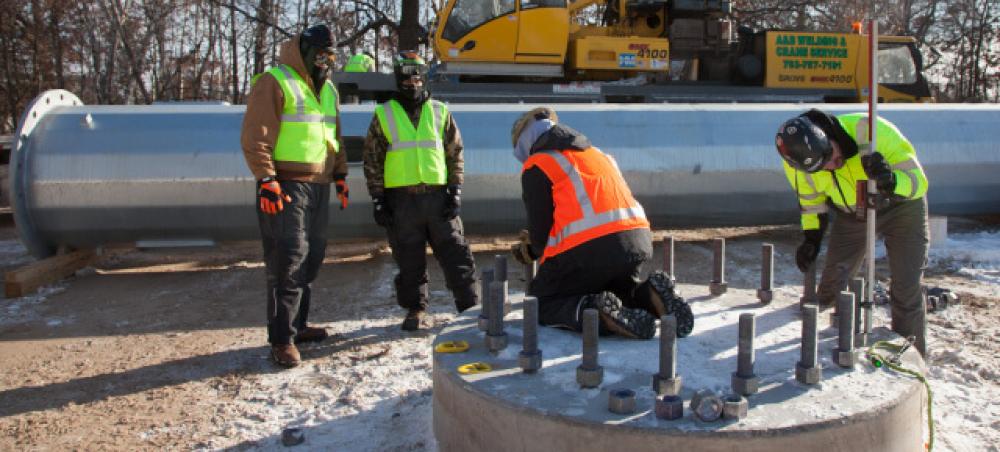Smart Scheduling For Winter Work Safety – Toolbox Talks

Toolbox Talks are intended to facilitate worksite health and safety conversations. Click here to download talking points on working smarter in cold temps to share with your crew.
They say you should only worry about stuff you can control. If you’re a safety supervisor, weather is one thing you can’t control—but you can control your crews’ shift schedules. Often overlooked, it’s an easy way to mitigate the side effects of working in a cold environment.
SHORTER SHIFTS, INCREASED PRODUCTIVITY
Limiting exposure is key in the prevention of cold stress. The dangers only get worse as temps lower and the wind speed picks up.
So when it comes to setting your crew up for success in these conditions, think like a hockey coach: schedule shorter shifts to keep your crew fresh and productive. Planning for shorter shifts can include adjusting work schedules or rotations to the cold weather or plummeting temps. Scheduling shifts in the middle of the day allows you to take advantage of the solar heat load that accumulates on sunny days.
A work/break schedule based on air temperature and wind speed is a smart tool for determining the number and length of work breaks needed during the course of a shift.
How to use the work/break schedule:
- Across the top row, locate the day’s predicted wind speed
- Down the left side, locate today’s predicted air temperature
- Follow across and down to find the recommended work time and warm-up/break-time in a four hour shift
These administrative controls (as they’re known on the Hierarchy of Controls) will help to reduce the physical demands of the workers, and, in the long run, actually increase productivity and worker safety. When none of the above options are viable, adding relief workers can more effectively distribute workload.

DRINK UP! DEHYDRATION IN THE DEEP FREEZE
As counterintuitive as increasing productivity with shorter shifts sounds, so does the need for staying hydrated while working in the cold. But the fact is, dehydration is as common in winter months as it is summer months. The reason? Cold weather tends to move body fluids from your extremities to your core, increasing your urine output and adding to dehydration.
Just because you’re not sweating as much as you would in the blazing heat of July, that doesn’t mean you’re not losing moisture. In fact, you can literally see it leaving your body when temps hit freezing and your breath becomes visible.
A dehydrated body is more susceptible to common colds and flu, which are more prevalent in winter. So, don’t rely on thirst to tell you when you need a drink in a cold climate.
THE BIG (WIND)CHILL
There are two sets of factors that come into play when considering the causes of cold stress on the body. The first being personal factors (read more about these in Recognizing Hypothermia, Frostbite and Other Common Cold-Related Illnesses). The second set includes environmental factors, such as cold air temperatures, wind speed, dampness of the air and contact with cold surfaces (hence the importance of thermal work gloves).
A cold environment forces the body to work harder to maintain its temperature. Cold ambient air temperature, water, and snow all draw heat from the body. High wind speeds and dampness work to accelerate heat loss.

The NWS (National Weather Service) Windchill Temperature (WCT) index provides a useful formula for calculating the dangers from winter winds and freezing temperatures.
For example, when the air temperature is 40°F, and the wind speed is 35 mph, your exposed skin receives conditions equivalent to the air temperature being 28° F. Much more of an impact with the exposure to wind, than without.
The index:
- Calculates wind speed at an average height of five feet, typical height of an adult human face, based on readings from the national standard height of 33 feet, typical height of an anemometer
- Is based on a human face model
- Incorporates heat transfer theory, heat loss from the body to its surroundings, during cold and breezy/windy days
- Lowers the calm wind threshold to 3 mph
- Uses a consistent standard for skin tissue resistance
- Assumes no impact from the sun (i.e., clear night sky)
COLD STRESS + FEDERAL REGULATIONS
So what about OSHA? OSHA does not have any regulation around cold stress, nor do they have any special campaigns around it like heat stress. Additionally, no states have adopted a cold stress standard. If there is a cold stress incident, they will however fall back on the General Duty Clause and issue citations based on those parameters.
“… pursuant to Section 5(a)(1) of the OSH Act, employers must provide their employees with a workplace free from recognized hazards likely to cause death or serious physical harm."
- General Duty Clause

WHAT’S YOUR COLD STRESS PREVENTION PLAN?
Every jobsite that does wintertime or cold exposure work should have a cold stress prevention plan in place. Supervisors should know the signs and symptoms of cold-related illnesses as well as the proper response, and remind their workers of those during daily or weekly safety briefings. You should also provide comprehensive cold stress training and a break area for workers with heaters and windbreaks. Remind workers to pace themselves, but keep emergency supplies on hand just in case.
Other suggested administrative controls include:
- Enclose the work area
- Remove snow and ice from heavily traveled areas such as parking lot and sidewalks
- Schedule outdoor work in warmer months or at the warmest times of the day, and don’t schedule demanding work in extreme temps
- Encourage your crews to wear insulated and waterproof footwear and keep a dry change of clothing with them
Workers may slow down in cold weather, but that doesn’t mean productivity has to freeze as well. A little planning and forethought can go a long way.
TALK TO YOUR CREW
The reality is that work doesn’t stop when the temperature drops. So taking a few minutes before a shift to educate your crew on how to work smarter in cold temps is a simple yet effective measure for reducing risk and boosting productivity.
Share this PDF with your crew to educate them on working smarter in cold temperatures.
MORE TOOLBOX TALKS:
- Recognizing Hypothermia, Frostbite and Other Common Cold-Related Illnesses
- Why Resting Under Shade Matters
- How to Prevent Dehydration



